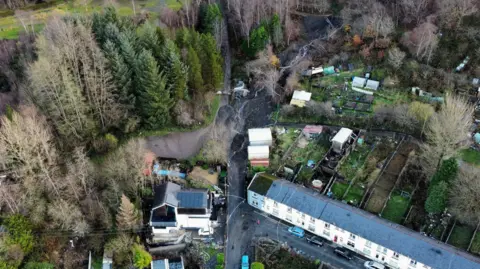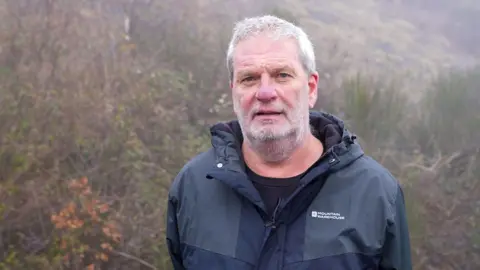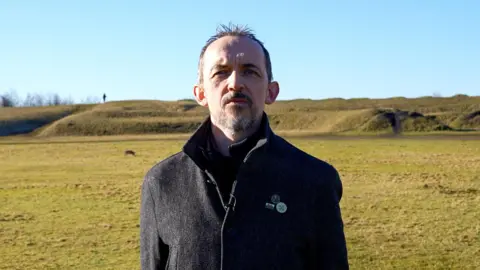Coal tips moved to 'most at risk' list since 2022
 Reuters
ReutersSeveral coal tips have been reassessed over the past two years as ones that could pose a risk to public safety.
A Freedom of Information (FOI) request by BBC Cymru Fyw showed the Welsh government had moved 11 tips to categories C and D - the most serious - since November 2022.
This was mainly due to an increase in rainfall and severe weather.
The new figures have raised concerns among some people living near coal tips, with some saying that information had not been adequately shared.
The Welsh government said it had invested over £100m in coal tip safety recently and regularly inspects those at the highest risk.
In October, the UK government announced in its budget that it would provide £25m to secure Welsh coal tips.
But concerns were raised again in November after heavy rainfall during Storm Bert caused a landslide in Cwmtillery, Blaenau Gwent.
The landslide originated from a coal tip above the area, and one resident said the event reminded her of the Aberfan disaster.
In 1966, 144 people - including 116 children - were killed when a coal tip slid down a mountainside and buried the village primary school.
The data from the FOI showed that since November 2022, 13 coal tips had been upgraded to a higher risk category, with 11 moved to the most serious categories - C and D.
The tips are divided into five categories - R, A, B, C, and D.
Category R includes tips that had been removed or built over, while category D tips were inspected at least twice a year.
The Welsh government began keeping records as part of the response to the February 2020 coal tip landslide in Tylorstown, Rhondda Cynon Taf.
It lists 360 tips as Category C and D, or as ones that "have the potential to impact public safety" and require regular inspection.
There are 2,573 coal tips in Wales.

Stuart Adams, a Caerphilly resident, is very familiar with the local coal tips as an avid walker.
He said he had noticed changes, such as "water channels getting bigger", particularly after heavy rain.
"You can see the erosion," he said.
His late father-in-law was one of the first firefighters to respond to the Aberfan disaster, and Stuart said the event remained "ingrained in people's memories".
The current discussion about the condition of Wales' coal tips is certain to raise concerns about "another Aberfan", he said.
There are four category C and D coal tips in the Gwaelod-y-Garth area on the outskirts of Cardiff, including one that recently moved from category B to C.
Ena Lloyd, who has lived in the area for nearly 25 years, said changes to the coal tip concern her.
She feels the relevant authorities have a "duty" to share information about any changes to the tip's condition.
"I walk in that area several times a week, and if we, the public, don't know the information, it makes me think - the authorities aren't doing their job properly," she said.

Ena is also part of Nature by the Taff group and said there was not enough awareness of the latest information.
"The people involved in the group tend to know what's happening locally in the environment [but] no-one has talked about the fact that there have been changes to the tip [in Gwaelod-y-Garth], and they're the kind of people who would know," she said.
"That worries me a bit that the information hasn't been shared."
Dr Rhian Meara, a geologist and senior lecturer in geography at Swansea University, explained that coal tips are made of "very fine materials" that "aren't bound together".
Heavy rainfall carries these fine materials, making the tip more unstable.
She noted that more rain and storms were likely due to climate change but added that people should not "worry day to day", as more monitoring work was being done.
"It is concerning to see a number of tips being reclassified to appear worse," she said.
"But on the other hand, as they move into these higher categories, they are being monitored more closely, tracked and prioritised."

The location of coal tips in Wales is relatively unique, according to Dr Ben Curtis, a historian of the coal industry at Swansea University.
"Here in the south... the topography is full of valleys, and there weren't many suitable places to put the coal waste, so they would pile it on the hillsides," he said.
"They are a visible symbol of how the coal industry shaped the valleys - but they also continue to show the potentially quite negative impact of the industry on the environment and landscape."
He added that "clearing [the tips] is going to be a long and costly process", but that "the cost of not dealing with the situation comprehensively could potentially be far worse".

Since being appointed to the House of Lords, Carmen Smith has been critical of the Welsh and UK governments' response to tip restoration.
Baroness Smith said the Welsh government should review the funding allocated to secure tips, given the reclassification of some to higher-risk categories.
She also argued that more information should be shared with the public.
"The Welsh government's efforts to publish maps of where the coal tips are located is an important step," she said, "but communities need to be convinced that the tips are being monitored regularly".
She added that the government's Disused Mine and Quarry Tips (Wales) Bill is "good progress" but was too late.
"What's disappointing is that the authority this bill sets to create won't be in place until April 2027, and that is the authority that they plan to use to come up with the remediation plans, so I fear that we won't see remediation until 2028 at least," she said.
"There's so much that can happen before that takes place."
Analysis by Environment Correspondent Steffan Messenger
Work to compile a register of Wales' disused tips got under way five years ago, after that frightening landslide above Tylorstown.
Many will find it hard to believe that so little was known - or had been forgotten - about the state of most of them.
The Welsh government says the dataset had reached a "reasonable level of completeness" by November 2022.
Since then, BBC Cymru Fyw's figures show that a number of tips have been reassessed as higher risk, as the new inspection regime beds in.
Legislation is currently making its way through the Senedd to establish a public body to manage this vital work of overseeing tip safety in future.
The way the tips are categorised is changing too - moving from using letters to numbers.
Another example of how the government says its trying to make it easier for people to understand about tips where they live is with maps and other details already available online.
But as this and other stories have shown, in communities across Wales some are still only becoming aware of the potential risk, and feel the authorities need to be more proactive with sharing information locally.
In response, the Welsh government said: "We want to ensure our coal tip communities are safe, both now and in the future, and that is why we have invested more £100m in coal tip safety this Senedd term.
"We have also introduced modern legislation - the first of its kind in the UK - to prevent disused coal and non-coal tips from being a threat to human life.
"The highest risk coal tips (category C and D) are regularly inspected by the Mining Remediation Authority and we continue to work with partners across Wales to inspect sites, including additional checks during extreme weather events."
